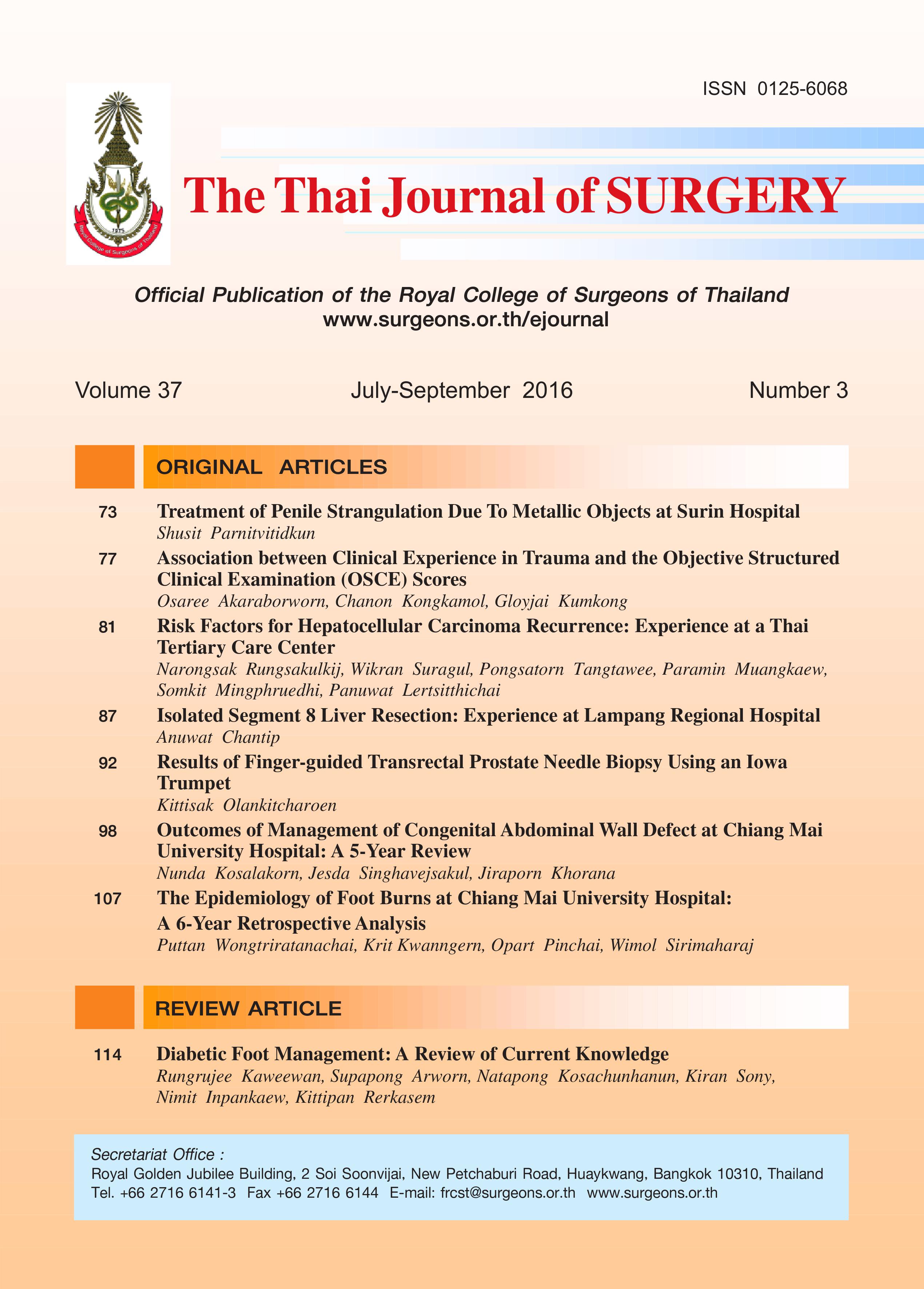Risk Factors for Hepatocellular Carcinoma Recurrence: Experience at a Thai Tertiary Care Center
Keywords:
Hepatocellular carcinoma, local recurrence, risk factors, microvascular invasion, hepatectomyAbstract
Background: Hepatocellular carcinoma (HCC) is the most common primary liver cancer worldwide. Liverresection is the treatment of choice for early HCC. The recurrence rate after curative resection is a major problem.
Purposes: To identify risk factors for HCC recurrence after curative resection. Methods: A retrospective review of medical records of patients with HCC who underwent curative resection
during the period January 2006 to September 2011.
Results: One hundred and thirty five patients were included in the study. There were 100 men (74%) and 35
women (26 %). The overall recurrence rate was 50 % (67/135) with a mean follow-up time of 40.7 months. The most
significant risk factor for tumor recurrence was the presence of vascular invasion.
Conclusion: The recurrence rate was 50 %. Vascular invasion was found to be a significant risk factor for HCC
recurrence.
References
in Thailand. Jpn J ClinOncol 2002;32:S82-91.
2. Jemal A, Siegal R, Xu J, et al. Cancer statistics. 2010. CA Can
J Clin 2010;60:277-300.
3. Imamura H, Seyama Y, Kokudo N, et al. One thousand fiftysix
hepatectomies without mortality in 8 years. Arc Surg
2003;138:1198-206.
4. Fan ST, Lo CM, Liu CL, et al. Hepatectomy for hepatocellular
carcinoma toward zero hospital deaths. Ann Sur 1999;
229:322-30.
5. Imamura H, Matsuyama Y, Tanaka E, et al. Risk factors
contributing to early and late phase intrahepatic recurrence
of recurrence of hepatocellular carcinoma after
hepatectomy. J Hepatol 2003;38:200-7.
6. Cha C, Fong Y, Jarnagin WR, et al. Predictors and patterns
of recurrence after resection of hepatocellular carcinoma.
J Am Coll Surg 2003;197:753-8.
7. Poon RT, Fan ST, Wong J. Risk factors, prevention, and
management of postoperative recurrence after resection
of hepatocellular carcinoma. Ann Surg 2000;232:10-24.
8. Ho CM, Wu CY, Lee CH, et al. Analysis of the risk factors of
untransplantable recurrence after primary curative resection
for patients with hepatocellular carcinoma. Ann Surg Oncol
2013;20:2526-33.
9. Qin LX, Tang ZU. The prognostic significance of clinical and
pathological features in hepatocellular carcinoma. World J
Gastroenterol 2002;8:193-9.
10. Rodriguez-Peralvarez M, Luong TV, Andreana L, et al. A
systematic review of microvascular invasion in hepatocellular
carcinoma: diagnostic and prognostic variability. Ann
SurgOncol 2013;20:325-39.
11. Portolani N, Coniglio A, Ghidoni S, et al. Early and late
recurrence after liver resection for hepatocellular carcinoma
prognostic and therapeutic implications. Ann Surg
2006;243:229-35.
12. Wang CC, Iyer SG, Low JK, et al. Perioperative factors
affecting long-term outcomes of 473 consecutive patients
undergoing hepatectomy for hepatocellular carcinoma.
Ann SurgOncol 2009;16:1832-42.
13. Meniconi RL, Komatsu S, Perdigao F, et al. Recurrent
hepatocellular carcinoma: A Western strategy that
emphasizes the impact of pathologic profile of the first
resection. Surgery 2015;157:454-62.
14. Sumie S, Nakashima O, Okuda K, et al. The Significance of
classifying microvascular invasion in patients with
hepatocellular carcinoma. Ann Surg Oncol 2014; 21:1002-9.
15. Nagasue N, Ono T, Yamanoi A, et al. Prognostic factors and
survival after hepatic resection for hepatocellular carcinoma
without cirrhosis. Br J Surg 2001;88:515-22.
16. Fan ST, Poon RT, Yeung C, et al. Outcome after partial
hepatectomy for hepatocellular cancer within the Milan
criteria. Br J Surg 2011;98;1292-300.
17. Lim KC, Chow PK, Allen JC, et al. Microvascular invasion is a
better predictor of tumor recurrence and overall survival
following surgical resection for hepatocellular carcinoma
compared to the Milan criteria. Ann Surg 2011;254:108-13.
18. Mazzaferro V, Regalia E, Doci R, et al. Liver transplantation
for the treatment of small hepatocellular carcinomas in
patients with cirrhosis. N Engl J Med 1996;334:693-9.
19. Poon RT, Fan ST, Lo CM, et al. Difference in tumor invasiveness
in cirrhotic patients with hepatocellular carcinoma fulfilling
the Milan criteria treated by resection and transplantation
impact on long-term survival. Ann Surg 2001;245:51-8.
Downloads
Published
How to Cite
Issue
Section
License
Articles must be contributed solely to The Thai Journal of Surgery and when published become the property of the Royal College of Surgeons of Thailand. The Royal College of Surgeons of Thailand reserves copyright on all published materials and such materials may not be reproduced in any form without the written permission.



